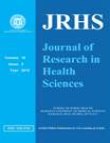Patterns of Inheritance of Essential Hypertension in Hundred Iranian Families
Author(s):
Pour , Jafari H. , Mg , Emami F. , Mohammad Hassani Mr.
Abstract:
Background
Essential hypertension tends to a familial mode. Its pattern of inheritance is heterogeneous, but the frequencies of different mode of inheritance vary in different populations. Determining of the mode of in heritance in each family is the basic information that is needed for the risk estimation in those family mem bers. Determination of pattern of inheritance in families with at least two members affected with essential hypertension in Hamadan city, west of Iran, was the goal of the present paper. Methods
The present study was a cross sectional descriptive one. The cases were patients in Dr Emami Clinic in Hamadan that were diagnosed as essential hypertension and also a familial recurrence pattern among their families. Then we prepared a suitable questionnaire containing some questions about their medical and family histories as well as pedigree containing 3 to 4 generations. After drawing their pedigree we determined their patterns of inheritance based on the standard method. The data were expressed in tables according to our variables to show the results. Totally we could include 100 families in this study. Results
The number of live patients in 100 studied families was 285 (84 males and 201 females, aver-age=62.7 y). Our primary results showed that the ages of diagnoses were from 30 to 81 y (average 54.24) for men and 28, 90 and 54.127 y in that order for women. The consanguineous marriages were done in 10.52% of the parents of affected persons (8.07% degree 3 and 2.45% degree 4). Frequencies of patients in different age groups, according to the age of diagnosis, were statistically significant (P<0.05), but not significant between the males and females. Our family study and pedigree patterns of essential hypertension showed that the mode of inheritance in 40% of families was autosomal dominant. Autosomal recessive was the pedigree pat tern of 8% of our cases. Although in 52% of remainders the mode of inheritance was familial, but there were not enough evidences for single gene trait. It seemed that in recent families the etiology of the defect was multi factorial. Conclusion
Essential hypertension in our subject families was heterogenic. Their frequency orders were multifactorial, autosomal dominant and autosomal recessive trait, respectively. Such order is adopted with the literature but it seems that in our population, the essential hypertension with autosomal recessive mode is more frequent than the western populations.Language:
English
Published:
Journal of Research in Health Sciences, Volume:6 Issue: 1, Winter-Spring 2006
Page:
4
magiran.com/p517572
دانلود و مطالعه متن این مقاله با یکی از روشهای زیر امکان پذیر است:
اشتراک شخصی
با عضویت و پرداخت آنلاین حق اشتراک یکساله به مبلغ 1,390,000ريال میتوانید 70 عنوان مطلب دانلود کنید!
اشتراک سازمانی
به کتابخانه دانشگاه یا محل کار خود پیشنهاد کنید تا اشتراک سازمانی این پایگاه را برای دسترسی نامحدود همه کاربران به متن مطالب تهیه نمایند!
توجه!
- حق عضویت دریافتی صرف حمایت از نشریات عضو و نگهداری، تکمیل و توسعه مگیران میشود.
- پرداخت حق اشتراک و دانلود مقالات اجازه بازنشر آن در سایر رسانههای چاپی و دیجیتال را به کاربر نمیدهد.
In order to view content subscription is required
Personal subscription
Subscribe magiran.com for 70 € euros via PayPal and download 70 articles during a year.
Organization subscription
Please contact us to subscribe your university or library for unlimited access!


